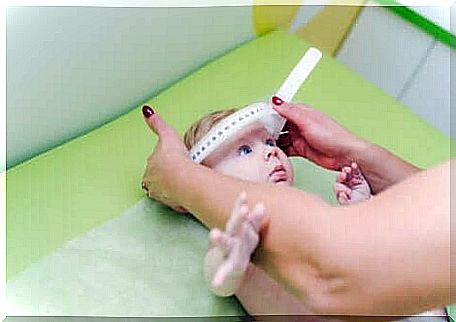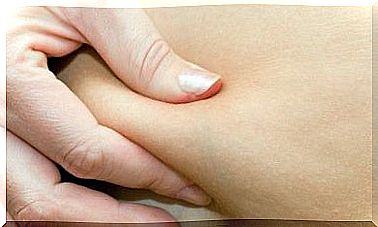Craniosynostosis: Types, Causes And Treatment
Some of the complications that craniosynostoses can generate over time are cognitive deterioration and endocranial hypertension syndrome. Read on to find out more !

Craniosynostosis is a congenital medical condition characterized by deformities in the cranial cavity. It occurs as a result of the premature closure of the cranial sutures.
The purpose of these sutures is to unite the bones of the skull and facilitate their movement during childbirth, and then close again over the weeks following birth.
This disease can lead to severe complications if it is not given proper treatment. If you want to know more, we invite you to read on.
Types of craniosynostosis
Since there are several sutures in the skull, craniosynostoses are classified according to their premature closure. The more brain growth is prevented, the greater its severity. We will now present some of them to you.
1. Scaphocephaly
When the sagittal suture (which unites the two parietal bones) closes prematurely, a case of scaphocephaly occurs. This is the most common, according to a publication from the Centers for Disease Control and Prevention (CDC). Affected patients have a skull that is more elongated in the anteroposterior axis.
2. Plagiocephaly
In this case, it is the coronal suture that is involved. This extends from the lateral part of the skull to the sagittal suture. Even though this structure is on either side, plagiocephaly only refers to unilateral closure. This case is associated with a flattening at the level of the forehead, on the corresponding side.
3. Trigonocephaly
From a clinical point of view, it is characterized by a flattening in the form of a triangle with an anterior vertex at the level of the forehead. It is unusual and is due to the premature closure of the metopic suture. This runs from the top of the nose to the sagittal suture.
4. Brachycephaly
Do you remember that in plagiocephaly one of the two coronal sutures closes? In some cases, the defect can be bilateral. In this case, we speak of brachycephaly. The malformation consists of a reduction in the anteroposterior diameter, which causes the head to be elongated upwards.
5. Oxycephaly
This term is ambiguous because it can refer both to the premature closure of all sutures and to the combination of the coronal suture and any other. Due to the limitations which are important for the growth of the brain, it is the most serious type. It is usually accompanied by other birth defects, such as the fusion of two or more fingers (syndactyly).

Causes of craniosynostosis
In the majority of cases, the exact cause of this group of diseases is unknown. There are several syndromes associated with genetic mutations, in which the incidence of craniosynostosis is greater. Some of them are Apert and Crouzon syndrome, both of which are characterized by multiple facial deformities.
With regard to environmental factors, we have been able to identify several risk factors. These are conditions that increase the likelihood that a child will be born with this defect. Some of them, the exposure of which occurs during pregnancy, are as follows:
- Tobacco consumption.
- Thyroid pathology in the mother.
- Use of clomiphene citrate.
Symptoms of craniosynostosis
The clinical manifestations depend on the severity of the malformations. Obviously, these are worse in the case of syndromic craniosynostoses, which are those associated with other genetic diseases.
Many of the symptoms are difficult to determine in the first few months of life, so patients may experience constant crying and irritability. In addition to the obvious deformity in the skull, some of the more prominent symptoms are as follows:
- Headache.
- Decreased visual acuity.
- Delay in psychomotor development.
- Abnormal development of the cephalic circumference.
Possible complications
Complications arise when treatment is not started in a timely manner, which can happen due to a delay in diagnosis. Some of these clinical conditions can put the patient’s life at risk, while others compromise their future quality of life. The most common are the following:
- Endocranial hypertension syndrome: when brain growth is steadily restricted, the existing pressure can exceed bearable limits. This syndrome is characterized by constant vomiting, severe headache and loss of visual acuity.
- Mental retardation: Cognitive development can be initiated if the defect is very complex or if the patient is not receiving treatment.
- Optic atrophy and blindness: Due to the increased pressure inside the skull, the optic nerve can suffer irreparable damage over the months.
- Seizures: This is also a consequence of restriction of brain growth and increased pressure in the skull.
- Self-esteem issues: If the defect cannot be resolved, it can lead to serious bullying issues. This and other psychological problems are common in these patients.
Diagnosis of craniosynostosis
If the prenatal check-up is done properly, especially in mothers with risk factors, it is possible to arrive at the diagnosis during intrauterine development. This can be done with a morphological echosonography, which is usually done from 20 weeks of pregnancy.
After birth, the diagnosis is usually obvious and is made immediately. However, in the lightest cases, it is possible to miss it. As in normal cases, the sutures should be permeable so that the fetus can pass through the birth canal; during the first hours of life, it is possible to observe small deformations and then we do not think of craniosynostosis.
Over time, these deformities become more evident. At this time, the diagnosis can be made during a pediatric evaluation, during which the doctor realizes the absence of an anterior fontanel.
This is a space in the front of the skull, right where several sutures connect. It usually closes spontaneously before the two years of life.

Treatment
Neurosurgery is the definitive treatment. However, it can only be done under certain conditions. In fact, mild cases may not require intervention. Skull development often normalizes over time, and special helmets are even recommended to model its development.
When the operation is indicated, it aims to decrease the malformation and promote adequate growth of the skull. Since many cases of craniosynostosis are associated with genetic syndromes and there may be complications related to defects in neurodevelopment, these patients generally require ongoing medical consultations.
What should you remember about craniosynostosis?
Craniosynostosis is a common malformation that requires, in all cases, a medical examination. If a loved one suspects this diagnosis, it is recommended to go to a pediatrician. This will perform an initial examination and may refer the patient to a neurosurgeon.









